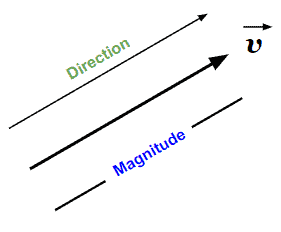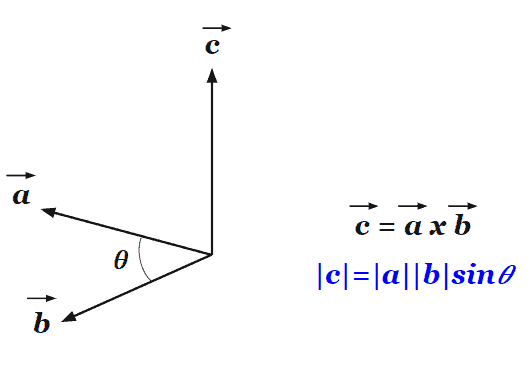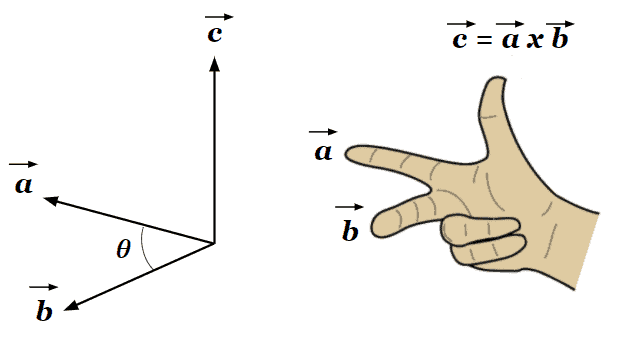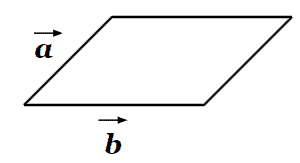- Home
- >
- Cross product – Explanation & Examples
JUMP TO TOPIC
Cross Product – Explanation & Examples
If we multiply two vectors, we get another vector that is perpendicular to both the original vectors. This operation is taking the cross product. We can use the cross product to find the direction perpendicular to two given vectors, find the area spanned by two vectors, determine if two vectors are orthogonal, etc. So, what exactly is a cross product?The cross product of two vectors gives us the vector that is perpendicular to the plane that is made up by both the original vectors.In this lesson, we will look at what a cross product is, the cross product’s formula, and how to do cross product. Let’s get started!What is a Cross Product?
First of all, we can take a cross product on two three-dimensional vectors! It is an operation done on two $ 3D $ vectors that result in a third vector perpendicular to both the original vectors and has a magnitude of the 1st vector times the magnitude of the 2nd vector times the sine of the angle between the two vectors.Let’s recall vectors, In the figure shown above, we have a vector $ \overrightarrow{ v } $. The magnitude of this vector is its length, and the direction of the vector is shown.Now, if we take the cross product of two vectors, $ \overrightarrow{ a } $ and $ \overrightarrow{ b } $ , the resultant vector will be $ \overrightarrow{ c } $, as shown in the figure below:
In the figure shown above, we have a vector $ \overrightarrow{ v } $. The magnitude of this vector is its length, and the direction of the vector is shown.Now, if we take the cross product of two vectors, $ \overrightarrow{ a } $ and $ \overrightarrow{ b } $ , the resultant vector will be $ \overrightarrow{ c } $, as shown in the figure below: Note that when finding a cross product, you may notice two directions perpendicular to both the original vectors. Upwards and downwards. To find which of these directions the cross product uses, we will use the right-hand rule.
To use the right-hand rule, you hold your right hand, pointing your index finger in the first vector’s direction. Then, turn your middle finger in towards the direction of the second vector. Hold your thumb up. Your thumb should now point in the direction of the cross product vector.
Note that when finding a cross product, you may notice two directions perpendicular to both the original vectors. Upwards and downwards. To find which of these directions the cross product uses, we will use the right-hand rule.
To use the right-hand rule, you hold your right hand, pointing your index finger in the first vector’s direction. Then, turn your middle finger in towards the direction of the second vector. Hold your thumb up. Your thumb should now point in the direction of the cross product vector. Please note that if you change the order of the vectors ( switch $ \overrightarrow{ a } $ and $ \overrightarrow{ b } $ ), the direction of the cross product vector will be opposite. Thus, the cross-product operation is not commutative; the order does matter! Thus, switching the inputs will give us a result that is exactly the opposite of the original. We will see it later on in an example.
Please note that if you change the order of the vectors ( switch $ \overrightarrow{ a } $ and $ \overrightarrow{ b } $ ), the direction of the cross product vector will be opposite. Thus, the cross-product operation is not commutative; the order does matter! Thus, switching the inputs will give us a result that is exactly the opposite of the original. We will see it later on in an example.Cross Product Formula
As we mentioned, the cross product is defined for 3-dimensional vectors. We can write vectors in component form, for example, take the vector $ \overrightarrow{ a } $,$ \overrightarrow{ a } = <a_{ 1 }, a_{ 2 }, a_{ 3 }> $The $x-$component is $a_{ 1 }$, the $y-$ component is $a_{ 2 }$, and the $z-$ component is $a_{ 3 }$. Now, let’s consider the two vectors shown below:$ \overrightarrow{a} = <a_{ 1 }, a_{ 2 }, a_{ 3 }> $$ \overrightarrow{b} = <b_{ 1 }, b_{ 2 }, b_{ 3 }> $The cross product of $ \overrightarrow{ a } $ and $ \overrightarrow{ b } $ is given by the formula:$ \overrightarrow{ a } \times \overrightarrow{b} = <a_{ 2 } b_{ 3 } – a_{ 3 } b_{ 2 }, a_{ 3 } b_{ 1 } – a_{ 1 } b_{ 3 }, a_{ 1 } b_{ 2 } – a_{ 2 } b_{ 1 } > $This formula is a bit tedious to remember. But don’t worry, this formula arises from the determinant of a $ 3 \times 3 $ matrix.Recall the formulas for the determinant of a $ 2 \times 2 $ matrix and a $ 3 \times 3 $ matrix:For a square matrix of order 2:$ A = \begin{bmatrix} a & b \\ { c } & { d } \end{bmatrix} $The determinant is:$ det( A ) = \begin{vmatrix} a & b \\ { c } & { d } \end{vmatrix} = ad – bc $For a square matrix of order 3:$ B = \begin{bmatrix} a & b & c \\ d & e & f \\ g & h & i \end{bmatrix} $The determinant is:$ det(B) = \begin{vmatrix} a & b & c \\ d & e & f \\ g & h & i \end{vmatrix} = a \begin{vmatrix} e & f \\ {h} & {i} \end{vmatrix} – b \begin{vmatrix} d & f \\ {g} & {i} \end{vmatrix} + c \begin{vmatrix} d & e \\ {g} & {h} \end{vmatrix} = a( ei – fh ) – b( di – fg ) + c( dh – eg ) $Now, we can write the vectors $ \overrightarrow{ a } $ and $ \overrightarrow{ b } $ as a determinant of a $ 3 \times 3 $ matrix form shown below:$ \overrightarrow{ a } \times \overrightarrow{ b } = \begin{vmatrix} \overrightarrow{ i } & \overrightarrow{ j } & \overrightarrow{ k } \\ a_{ 1 } & a_{ 2 } & a_{ 3 } \\ b_{ 1 } & b_{ 2 } & b_{ 3 } \end{vmatrix} $Breaking it apart, we have:$ \overrightarrow{ a } \times \overrightarrow{ b } = \overrightarrow{ i } \begin{vmatrix} a_{2} & a_{ 3 } \\ b_{ 2 } & b_{ 3 } \end{vmatrix} – \overrightarrow{ j } \begin{vmatrix} a_{1} & a_{3} \\ b_{1} & b_{3} \end{vmatrix} + \overrightarrow{ k } \begin{vmatrix} a_{ 1 } & a_{ 2 } \\ b_{ 1 } & b_{ 2 } \end{vmatrix} = <a_{2} b_{3} – a_{3} b_{ 2 }, a_{ 3 } b_{ 1 } – a_{ 1 } b_{ 3 }, a_{ 1 } b_{2} – a_{ 2 } b_{ 1 }> $This is exactly the formula we showed a while ago!Note: The vectors $\overrightarrow{ i } $, $\overrightarrow{ j } $, and $\overrightarrow{ k } $ are the standard basis vectors that must appear in the order given.The best way to learn the cross product is to do an example. The next section shows one such example!How to do Cross Product
Let’s see an example that finds the cross product of $ a $ and $ b $ and $ b $ and $ a $.Given$ \overrightarrow{ a } = <1,-1,2> $$ \overrightarrow{ b } = <4,1,3> $Find $ \overrightarrow{ a } \times \overrightarrow{ b } $ and $ \overrightarrow{ b } \times \overrightarrow{ a } $.Let’s find $ \overrightarrow{ a } \times \overrightarrow{ b } $:We will write the two vectors in $ 3 \times 3 $ matrix form and compute the cross product using the determinant formula we know. The steps are shown below:$ \overrightarrow{a} \times \overrightarrow{b} = \begin{vmatrix} \overrightarrow{ i } & \overrightarrow{ j } & \overrightarrow{ k } \\ 1 & { – 1 }& 2 \\ 4 & 1 & 3 \end{vmatrix} $$ = \overrightarrow{ i } \begin{vmatrix} -1 & 2 \\ 1 & 3 \end{vmatrix} – \overrightarrow{ j } \begin{vmatrix} 1 & 2 \\ 4 & 3 \end{vmatrix} + \overrightarrow{ k } \begin{vmatrix} 1 & -1 \\ 4 & 1 \end{vmatrix} $$ = (- 3 – 2 )\overrightarrow{ i } – (3-8)\overrightarrow{ j } + (1+4 )\overrightarrow{k} $$ = -5\overrightarrow{ i } + 5\overrightarrow{ j } + 5\overrightarrow{ k } $Now, Let’s find $ \overrightarrow{ b } \times \overrightarrow{ a } $:$ \overrightarrow{b} \times \overrightarrow{ a } = \begin{vmatrix} \overrightarrow{ i } & \overrightarrow{ j } & \overrightarrow{k} \\ 4 & 1 & 3 \\ 1 & { – 1 }& 2 \end{vmatrix} $$ = \overrightarrow{ i } \begin{vmatrix} 1 & 3 \\ -1 & 2 \end{vmatrix} – \overrightarrow{ j } \begin{vmatrix} 4 & 3 \\ 1 & 2 \end{vmatrix} + \overrightarrow{ k } \begin{vmatrix} 4 & 1 \\ 1 & -1 \end{vmatrix} $$ = (2+3)\overrightarrow{ i } – (8 – 3)\overrightarrow{ j } + (-4-1)\overrightarrow{ k } $$ = 5\overrightarrow{ i } – 5\overrightarrow{ j } – 5\overrightarrow{ k } $Notice that switching the order of the vectors in the cross product changed all the signs! This means that the two cross products are opposite in direction! We noted this fact above when we learned the right-hand rule!It’s time for some examples and practice problems!Example 1
Calculate $ \overrightarrow{ a} \times \overrightarrow{ b } $ if$ \overrightarrow{ a } = < 2, 4, 8 > $$ \overrightarrow{ b } = < – 2, 0, 1 > $SolutionWe will write the two vectors in $ 3 \times 3 $ matrix form and compute the cross product using the determinant formula we know. The steps are shown below:$ \overrightarrow{ a } \times \overrightarrow{b} = \begin{vmatrix} \overrightarrow{ i } & \overrightarrow{ j } & \overrightarrow{ k } \\ 2 & 4 & 8 \\ -2 & 0 & 1 \end{vmatrix} $$ = \overrightarrow{ i } \begin{vmatrix} 4 & 8 \\ 0 & 1 \end{vmatrix} – \overrightarrow{ j } \begin{vmatrix} 2 & 8 \\ -2 & 1 \end{vmatrix} + \overrightarrow{ k } \begin{vmatrix} 2 & 4 \\ -2 & 0 \end{vmatrix} $$ = ( 4 – 0 )\overrightarrow{ i } – (2+16)\overrightarrow{ j } + (0+8)\overrightarrow{ k } $$ = 4\overrightarrow{ i } – 18\overrightarrow{ j } + 8\overrightarrow{ k } $Thus, $ \overrightarrow{ a } \times \overrightarrow{ b } $ is equal to $ < 4, – 18, 8 > $.Example 2
Find out the area of the parallelogram that is spanned by the vectors $ \overrightarrow{ a } = < 6, −3, 1 > $ and $ \overrightarrow{b} = < 4, 9, 1 > $. SolutionThis example shows a geometric application of the cross product. The area of a parallelogram spanned by the vectors $\overrightarrow{ a }$ and $\overrightarrow{ b }$ is given by:$ || \overrightarrow{ a } \times \overrightarrow{ b } || $Let’s show the steps of finding the area of the parallelogram spanned by the vectors $ \overrightarrow{ a } $ and $\overrightarrow{ b }$:$ \overrightarrow{a} \times \overrightarrow{ b } = \begin{vmatrix} \overrightarrow{ i } & \overrightarrow{ j } & \overrightarrow{ k } \\ 6 & -3 & 1 \\ 4 & 9 & 1 \end{vmatrix} $$ = ( – 3 – 9 )\overrightarrow{ i } – ( 6 – 4 )\overrightarrow{ j } + ( 54+12 )\overrightarrow{ k } $$ = -12\overrightarrow{ i } – 2\overrightarrow{ j } + 66\overrightarrow{ k } $To find the area, we take the square root of the sum of the squares of each individual components of the cross product. Thus, the area of the parallelogram is:$ || \overrightarrow{ a } \times \overrightarrow{ b } || = \sqrt{( – 12)^2 + ( – 2 )^2 + (66)^2} = \sqrt{ 4504 } \approx 67.11 $
The area of a parallelogram spanned by the vectors $\overrightarrow{ a }$ and $\overrightarrow{ b }$ is given by:$ || \overrightarrow{ a } \times \overrightarrow{ b } || $Let’s show the steps of finding the area of the parallelogram spanned by the vectors $ \overrightarrow{ a } $ and $\overrightarrow{ b }$:$ \overrightarrow{a} \times \overrightarrow{ b } = \begin{vmatrix} \overrightarrow{ i } & \overrightarrow{ j } & \overrightarrow{ k } \\ 6 & -3 & 1 \\ 4 & 9 & 1 \end{vmatrix} $$ = ( – 3 – 9 )\overrightarrow{ i } – ( 6 – 4 )\overrightarrow{ j } + ( 54+12 )\overrightarrow{ k } $$ = -12\overrightarrow{ i } – 2\overrightarrow{ j } + 66\overrightarrow{ k } $To find the area, we take the square root of the sum of the squares of each individual components of the cross product. Thus, the area of the parallelogram is:$ || \overrightarrow{ a } \times \overrightarrow{ b } || = \sqrt{( – 12)^2 + ( – 2 )^2 + (66)^2} = \sqrt{ 4504 } \approx 67.11 $Practice Questions
- Calculate $ \overrightarrow{ a } \times \overrightarrow{ b } $ if$ \overrightarrow{a} = <z, – z, 2z> $$ \overrightarrow{b} = < z^{ 2 }, z, z^{ 3 }> $
- Find out the area of the parallelogram that is spanned by the vectors $ \overrightarrow{ a } = < 1, −1, 1 > $ and $ \overrightarrow{b} = < 2, -1, 2 > $.
Answers
- We will write the two vectors in $ 3 \times 3 $ matrix form and compute the cross product. Shown below:$ \overrightarrow{ a } \times \overrightarrow{ b } = \begin{vmatrix} \overrightarrow{ i } & \overrightarrow{ j } & \overrightarrow{ k } \\ z & – z & 2z \\ z^{ 2 } & z & z^{ 3 } \end{vmatrix} $$ = \overrightarrow{ i } \begin{vmatrix} -z & 2z \\ z & z^{ 3 } \end{vmatrix} – \overrightarrow{j} \begin{vmatrix} z & 2z \\ z^{ 2 } & z^{ 3 } \end{vmatrix} + \overrightarrow{k} \begin{vmatrix} z & -z \\ z^{ 2 } & z \end{vmatrix} $$ = (-z^{4}-2z^{2})\overrightarrow{ i } – (z^{ 4 } – 2z^{ 3 } )\overrightarrow{ j } + (z^{ 2 }+z^{ 3 } )\overrightarrow{k} $Thus, $ \overrightarrow{ a } \times \overrightarrow{ b } $ is equal to $ < -z^{ 4 } – 2z^{ 2 }, 2z^{ 3 } – z^{ 4 }, z^{ 2 }+z^{ 3 } > $.
- We know that the area of a parallelogram spanned by the vectors $\overrightarrow{ a }$ and $\overrightarrow{ b }$ is given by:$ || \overrightarrow{ a } \times \overrightarrow{ b } || $First, let’s find the cross product:$ \overrightarrow{ a } \times \overrightarrow{ b } = \begin{vmatrix} \overrightarrow{ i } & \overrightarrow{ j } & \overrightarrow{ k } \\ 1 & -1 & 1 \\ 2 & -1 & 2 \end{vmatrix} $$ = (-1+1)\overrightarrow{ i } – ( 1 – 2 )\overrightarrow{ j } + (-1+2)\overrightarrow{k} $$ = 0\overrightarrow{ i } + 1\overrightarrow{ j } + 1\overrightarrow{ k } $To find the area, we take the square root of the sum of the squares of each individual component of the cross product. Thus, the area of the parallelogram is:$ || \overrightarrow{ a } \times \overrightarrow{ b } || = \sqrt{ ( 0 )^2 + ( 1 )^2 + ( 1 )^2} = \sqrt{ 2 } \approx 1.41 $
